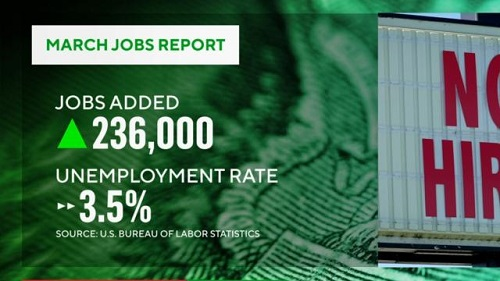Not with standing the nine interest rate increases the Federal Reserve implemented over the past year in an effort to control inflation, the economy is still in good shape.
A healthy 236,000 new jobs were created by American employers in March, indicating that the economy is still on solid ground despite the nine interest rate increases the Federal Reserve has imposed over the past year in an effort to rein in inflation.
A only 0.5% higher than the 53-year low of 3.4% reached in January, the jobless rate dropped to 3.5%.
Another encouraging clue for the Fed’s anti-inflationists is the fact that a sizable 480,000 Americans started looking for job in March. The more job seekers there are, the less pressure companies often feel to raise wages. Inflation pressures often ease as a result.
The government also decreased its estimate of job growth in January and February by a combined 17,000 in its report on Friday.
Sinem Buber, economist of the employment agency ZipRecruiter, stated that “the labour market continues to soften.” That ought to lessen inflationary pressures in the upcoming months and boost the Federal Reserve’s confidence in the forecast for inflation.
Government agencies, healthcare providers, and restaurants and bars were among the economic sectors that added jobs in March.
The newest economic indicators indicate that the economy may be slowing, which would help lower price pressures despite the solid job growth seen last month. Production is declining. Trade between America and the rest of the globe is decreasing. Also, even while businesses like eateries, shops, and other services are still expanding, it is happening more gradually.
The Fed’s top priority is to control inflation. When consumer prices began to rise in the spring of 2021, they were sluggish to act, assuming that it was merely a temporary effect of supply bottlenecks brought on by the economy’s unusually rapid recovery from the pandemic slump.
The Fed started gradually lowering its target rate from near zero only in March 2022. Nonetheless, in order to combat the worst inflation wave since the 1980s, it has hiked rates more forcefully than it had previously.
In addition, as borrowing prices increased, inflation gradually decreased. Consumer inflation is currently running at 6%, which is significantly lower than the 9.1% rate it peaked at in June of last year. Yet, it remains well above the Fed’s 2% target.
The banking system’s instability makes things more difficult. In March, two significant American banks failed, and rising interest rates and more stringent credit requirements might further weaken banks and reduce borrowing and spending by individuals and businesses.
In order to accomplish a “soft landing,” the Fed must limit growth just enough to control inflation without sending the world’s largest economy into a downturn. The majority of economists don’t think it will succeed; they anticipate a recession later this year.
The economy has so far shown itself to be resilient in the face of rising borrowing prices. In the second half of 2022, the United States’ gross domestic product—the overall output of goods and services—grew at a brisk rate. But, recent figures indicate that the economy is lagging behind.
Manufacturing activity in the United States decreased in March for the fifth consecutive month, according to a study released on Monday by the Institute for Supply Management, an association of buying managers. Two days later, the ISM reported that growth in the services sector, which makes up the vast bulk of employment in the United States, had dramatically slowed in December.
The Commerce Department announced on Wednesday that both U.S. exports and imports decreased in February, providing yet another indication of the worsening state of the world economy.
On Thursday, the Labor Department announced that it had modified the formula it uses to determine how many Americans are applying for unemployment benefits. The adjustment increased claims by almost 100,000 over the course of the previous two weeks, which may help to explain why significant layoffs in the IT sector this year have not yet appeared on the unemployment rolls.
According to a separate data released this week by the Labor Department, employers announced 9.9 million job opportunities in February, the fewest since May 2021 but still significantly greater than anything observed prior to 2021.
The Fed has expressed hope that employers will ease wage pressures by advertising fewer vacancies rather than by eliminating many existing jobs. The Fed has also expressed hope that more Americans will start looking for work, thereby increasing the supply of labour and reducing pressure on employers to raise wages.



